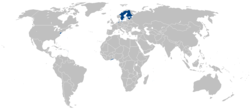Swedish overseas colonies
| Swedish Colonial Empire | ||||||
| Svenska kolonier (Swedish) | ||||||
|
||||||
|
||||||
|
Motto I Gud mitt hopp "In God my hope" |
||||||
|
Anthem Imperial anthem Kungssången "Song of the king!" |
||||||
|
Map of the Swedish Empire with all of the territories that it possessed at different time periods shown together.
|
||||||
| Capital | ||||||
| Languages | Official language: Swedish Regional languages: Norwegian, Finnish, Estonian, Russian |
|||||
| Religion | Official religion: Lutheran Minority religions: Roman Catholic, Protestant, Orthodox Christian |
|||||
| Government | Absolute monarchy by divine right | |||||
| History | ||||||
| • | Established | 1638 | ||||
| • | Disestablished | 1878 | ||||
| Population | ||||||
| • | 1650 est. | 2,200,000 | ||||
| Currency | Riksdaler | |||||
| Today part of | ||||||
Sweden possessed overseas colonies from 1638 to 1663 and from 1784 to 1878.
The former Swedish colonies in Africa were:
The former Swedish colonies in America:
By the middle of the 17th century, the Swedish Empire had reached its greatest territorial extent. The Swedes sought to extend their influence by creating an agricultural (tobacco) and fur trading colony to bypass French, British and Dutch merchants. The charter included Swedish, Dutch and German stockholders. Once they landed they established Fort Christina (now Wilmington, Delaware), named after Queen Christina of Sweden. Many of the settlers were Finnish, since until 1809 the area of modern Finland was the eastern third of the kingdom of Sweden.
The settlement was actually an invasion of New Netherland since it was Dutch territory. The founder and first governor, Peter Minuit, had been Director-General of New Netherland from 1626 to 1633. Disgruntled after being dismissed from his post, he led a Swedish expedition to a location which he knew to be strategic as well as a thorn in the side of his former employers. Minuit died on a return trip from in a hurricane near the Caribbean island of Saint Kitts. The colony would establish Fort Nya Elfsborg north of present-day Salem, New Jersey in 1643.
In May 1654 the Dutch Fort Casimir, located in present-day New Castle, Delaware was captured by New Sweden. As a reprisal, the Dutch governor Peter Stuyvesant sent an army to the Delaware River, which obtained the surrender of the Swedish forts.
...
Wikipedia



